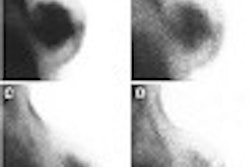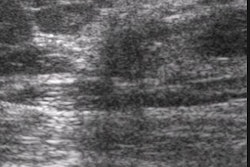A new mass-detection algorithm for computer-aided detection (CAD) could be beneficial to mammographers as a second opinion, according to its developers at the University of Michigan in Ann Arbor. Nicholas Petrick, Ph.D., and colleagues reported on their results in the latest issue of Radiology.
"Efforts to evaluate the usefulness of CAD in reducing the rate of missed cancers are ongoing," the authors wrote, citing several previous studies, including one in 2001 that tested the ImageChecker (R2 Technologies, Sunnyvale, CA) in a community breast cancer center and found that the CAD system had a cancer detection rate of 81.6%.
But "these results do not distinguish between cancers that appear on mammograms as masses alone, microcalcification clusters alone, or as a combination of mass and cluster," they added (Radiology, July 2002, Vol.224:1, pp. 217-224).
For this study, the group focused on the ability of CAD to mark preoperative masses, which they defined as "a palpable or nonpalpable mass that is identified during clinical or mammographic evaluation and either is selected for biopsy based on the results of the examination or is followed up and proves to be benign."
The training parameters for the algorithm were based on 253 clinical mammograms that had been previewed by a resident or fellow and then officially interpreted by a radiologist. The mammograms were acquired with MinR/MinR or MinR/MRE film-screen systems and digitized with a DIS-1000 laser film scanner (Eastman Kodak Health Imaging, Rochester, NY). The scans were divided into two groups.
"We used lesion-free mammograms of the breast contralateral to those breasts that contained an abnormality to estimate the CAD marker rate for the algorithm," the researchers explained. "Our mass-detection scheme uses adaptive enhancement, object-based border refinement, and feature classification to identify potential breast masses."
A mammogram was first digitized and then a density-weighted contrast enhancement (DWCE) filter was applied to "accentuate mammographic structures before edge detection by adaptively enhancing local contrast."
The computer program was trained with the entire set of 253 mammograms. The process included adjusting the filter, clustering, selected features, and classification thresholds. The algorithm turned in a training sensitivity of 81% overall and 85% for malignant masses.
"It is important to note that the detection classifiers considered only classification between breast masses and normal tissue, not classification between malignant and benign masses," the authors stated.
According to the final results, in Group 1, 34% of the malignant masses and 5% of the benign masses were spiculated. In Group 2, 33% of the malignant masses were spiculated, while spiculation was found in none of the benign cases.
The investigators then analyzed the sensitivity achieved by the mass-detection algorithm at three fixed normal marker rates. At a rate of 1.5 marks per mammogram, 87% of the malignant masses were detected; at 1 mark per mammogram, 83% were found; and at 0.5 marks per mammogram, 77% were found by the algorithm.
The researchers also found that the algorithm performed better in the detection of malignant masses than in benign ones. The main reason for this was because malignant masses were more likely to be spiculated, a characteristic that their algorithm was better at picking up.
"The estimated performance values for our detection algorithm compare well with published performance results for commercial CAD vendors (an 85.7% true-positive fraction at 0.5 mark per image with the R2 program and an 84% true-positive fraction at 1.1 marks per image with the CADx program by CADx Medical Systems, Laval, Quebec, Canada)," the group concluded.
The next research phase for the group’s algorithm is already underway, they said. The group will see how well the mass-detection algorithm performed with mammograms in which the lesions are not initially deemed actionable by the radiologist.
By Shalmali PalAuntMinnie.com staff writer
July 2, 2002
Related Reading
Mammographers question newspaper’s ‘crusade’ against breast imaging, June 28, 2002
CAD technology begins to make good on its promise, March 14, 2002
ECR studies explore CAD in breast screening, March 1, 2002
Copyright © 2002 AuntMinnie.com



















